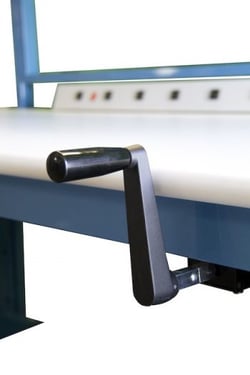An adjustable lab table is a popular choice today in many laboratory and manufacturing facilities because it allows for flexibility and promotes greater employee health.
It’s a movement that’s catching on quickly as more and more workplaces are prioritizing the wellbeing and productivity of their employees.
However, selecting the right mechanism for the adjustable table is equally important. With various options available, it's crucial to make the right decision in order to optimize the functionality and ergonomics of your workspace. Here’s how to choose the right height adjustment lab table mechanism and ultimately land on a choice that will meet your needs and provide long-term benefits.
Know Your Options
While all height adjustable lab tables rise and lower, the mechanism that makes this feature possible varies.
There are four lift mechanism options for your height adjustable lab table:
- Slot adjustment
- Hand crank
- Hand crank with hydraulic features
- Electric
Slot Adjustment
A worker makes adjustments by raising the lab table legs and removing bolts or spacers. This type of lab bench allows employees to adjust the height of the table top, but isn’t the most ergonomically-friendly option because it requires the worker to manually lift the bench.
Hand Crank
A hand crank adjustable table is manual in design, but allows employees to rotate a hand crank to lift or lower the table top. A hand crank makes the process of lifting the work area easier for employees, but if there are heavy tools, products or other objects on the bench, it may be difficult to raise and lower the worksurface.

Hand Crank With Hydraulic Features
When cranked, the hydraulic fluid in the cylinders force the shafts in the legs of the lab table to elevate. This pressure that lowers or lifts the work surface makes the process easier, especially with heavy duty lab tables that hold heavy loads. Depending on the workbench or lab table that you purchase, hydraulic adjustable versions can lift up to 1,000 pounds.
Electric
An employee can easily lift or lower the surface with the simple push of a button. If there are heavy work tools on the table, a bench with an electrical component will also require less physical effort to raise the table than hand cranking it. Depending on the model, you may be able to preset positions for convenience as well. This can come in handy if multiple workers use the same bench in multi-shift operations.

Reflect On Employee Health
While a slot adjustment and hand crank adjustable table still allows your workers to adjust the height of the bench, they’re not the most health-friendly options. The hand crank with hydraulic features and electric options are far more ergonomically-friendly.
Ergonomics centers around maintaining a relaxed position that minimizes stress on a person’s joints and muscles. The relationship between the height of a person and the height of the work table impacts this. Studies show that ergonomic interventions can lead to improvements in productivity and workflow while reducing work-related musculoskeletal disorders.
By shortening or elongating the legs of the bench so that an employee can sit or stand, employees can work at a supportive level. While all adjustable lab tables accomplish this, a hydraulic table and an electric table are far easier to rise and lower. Of the four mechanism options, the electric adjustable lab table requires the least effort to move.
Consider Costs
Budget is a consideration in almost every workplace. Choosing the right height adjustable lab table mechanism for your workspace will likely require this consideration.
While an electric adjustable height workbench offers several benefits, it may be at the top of the price range for adjustable lab tables. A lab table with hydraulic features is also likely to be more expensive than one with a manual crank.
On the other hand, when considering your budget, it’s important to keep in mind the long-term benefits and cost savings that may come with investing in a higher-quality, more ergonomic lab table. By reducing the risk of work-related injuries and promoting employee health and productivity, a more expensive adjustable lab table may ultimately save the company money in the long run.
Ultimately, when making budget considerations, it’s important to weigh the potential benefits and drawbacks of different options and to prioritize the health and well-being of employees while still staying within budget constraints.
Evaluate Other Needs
When choosing which type of height adjustable lab table mechanism is right for your workspace, it’s important to look at all of the needs of your facility, including the type of work that is performed there on a daily basis.
While an electric mechanism is faster, it also requires less effort, making it ideal for environments where higher weight capacities are needed for a lab table. Tools like microscopes, centrifuges and analytical balances are extremely heavy and can make lifting with a hand crank more difficult.
On the other hand, if your operations require a clean environment, the risk of oil leaks may be enough to prevent you from choosing hydraulic benches, since leaks can occur over time with heavy use.
While you may be focused on the mechanism of your adjustable lab table, keep in mind you’ll have other important decisions to make as well. These decisions include features like the table top material, organizational features and storage.
In fact, the work surface on your table top is one of the most important features you will choose since it is based on your lab’s applications. The countertop material you choose can also impact the weight of the table as a whole, making the mechanism decision even more important.
Here are some of the most commonly found in laboratories and manufacturing spaces:
- Phenolic Resin: Typically used in labs, and are designed as one solid, lightweight countertop that is durable and long-lasting.
- Epoxy Resin: Durable and non-porous, and holds up very well under harsh and extreme conditions such as high heat.
- Solid Surface: Solid surface countertops are often made from acrylic or polyester resins and feature a filler material. They are non-porous and water-proof, and feature many different customizable looks.
- Chemical Laminate: This countertop choice is budget friendly and is produced by layering melamine resin, layers of wood fibers and phenolic resin-impregnated Kraft paper with a decorative substrate. They are highly protective against chemical agents.
- High Pressure Laminate: Used for basic, non-extreme applications. While they are functional and durable, they’re also very affordable.
- ESD laminate: This material provides a safe work surface for environments where static electricity is a concern. As an added benefit, ESD laminate surfaces are also resistant to staining and chemicals that include acetone, gasoline and 10% ammonium solutions.
- Stainless Steel: Resistant to bacteria, rust and corrosion. They also are stain and heat resistant. This makes stainless steel an ideal choice for laboratories where high heat and open flames are used.
- Butcher Block: Traditionally used in woodworking and basic assembly applications. While this type of countertop is sturdy, it’s also porous and can dent easily. This type of material likely isn’t an appropriate choice for a laboratory workstation unless used in non-work areas or in labs where abrasive chemicals are not handled.
Other design considerations include:
- Drawer configurations
- Storage security
- Handle options
- Utility drawers
- Shelving
- Upper storage cabinets with flipper doors
- Articulating monitor arms that can accommodate flat screens and laptops
- Keyboard trays
- CPU holders that can be fixed or adjustable
- Pegboards that can be added between the uprights to attach tools
- Bin rails or panels to store parts and accessories
Finally, you may need your adjustable lab table to also be mobile. The mobility of a lab table can impact your mechanism choice as well since an electric table needs to be located near a power source in order to lift or lower. A mobile industrial workbench will include casters that make the workstation movable. Make sure the casters are industrial strength and can withhold the weight of your adjustable height work table.
Work With A High-Quality Manufacturer
Working with a high-quality adjustable lab table manufacturer is important to ensure you are getting the workstation you choose that meets all of your facility’s needs.
Laboratory furniture manufacturers should be experienced in your industry and offer customizations that help maximize productivity. The best manufacturers will offer exceptional customer service by providing reliable lead times and delivery. This is especially important if you’re working on a time constraint and need your lab table designed and delivered as quickly as possible.


